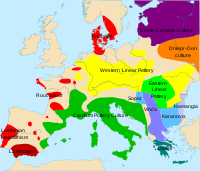
Identifying Experimental Tool Use Through Confocal Microscopy
Sign Up to like & getrecommendations! Published in 2018 at "Journal of Archaeological Method and Theory"
DOI: 10.1007/s10816-018-9408-9
Abstract: Characterizing use-wear traces quantitatively is a valid way to improve the capacity of use-wear analysis. This aim has been on specialists’ agenda since the beginning of the discipline. Micropolish quantification is especially important, as this… read more here.
Keywords: use; microscopy; analysis; journal archaeological ... See more keywords

Use of Wear-Resistant Materials in the Kazakhstani Metallurgical Industry
Sign Up to like & getrecommendations! Published in 2019 at "Metallurgist"
DOI: 10.1007/s11015-019-00755-5
Abstract: We provide an overview of requirements for wear-resistant materials in the Kazakhstani ore mining and smelting industry, and describe the basic variety of metallurgical parts and products produced using such materials. We describe why production… read more here.
Keywords: resistant materials; industry; use wear; kazakhstani metallurgical ... See more keywords

The function and flexible use of a Neolithic microlithic assemblage from the Huihe dam site, Inner Mongolia: a quantifiable analysis of use-wear evidence
Sign Up to like & getrecommendations! Published in 2020 at "Archaeological and Anthropological Sciences"
DOI: 10.1007/s12520-020-01032-2
Abstract: Microblade technology played a key role in the everyday lives of the occupants of Inner Mongolia during the Neolithic period. However, the functional aspect of the microblade assemblage and its role had not been widely… read more here.
Keywords: use; inner mongolia; neolithic microlithic; site ... See more keywords

The role of pottery in Middle Neolithic societies of western Mediterranean (Sardinia, Italy, 4500-4000 cal BC) revealed through an integrated morphometric, use-wear, biomolecular and isotopic approach
Sign Up to like & getrecommendations! Published in 2018 at "Journal of Archaeological Science"
DOI: 10.1016/j.jas.2018.03.005
Abstract: Abstract The use of pottery in the Early Neolithic communities of Western Mediterranean has begun to be addressed by recent studies concerning the residues of dietary commodities in potsherds. In order to contribute to a… read more here.
Keywords: pottery; use wear; western mediterranean; neolithic societies ... See more keywords

Technological and behavioural complexity in expedient industries: The importance of use-wear analysis for understanding flake assemblages
Sign Up to like & getrecommendations! Published in 2019 at "Journal of Archaeological Science"
DOI: 10.1016/j.jas.2019.105031
Abstract: Abstract Expedient lithic technology has been described as unchanging and without or very limited presence of formal tool types. However, this premise seems to limit the discussion on technological and behavioural complexity when studying amorphous… read more here.
Keywords: use; analysis; use wear; wear analysis ... See more keywords

Use-wear analysis of Early Mesolithic flake axes from South-eastern Norway
Sign Up to like & getrecommendations! Published in 2018 at "Journal of Archaeological Science: Reports"
DOI: 10.1016/j.jasrep.2017.12.017
Abstract: Abstract The flake axe is one of the most debated stone tools of the Scandinavian Mesolithic. Few analysis have however been carried out in order to investigate the actual function and use of the tool.… read more here.
Keywords: early mesolithic; flake axes; analysis; wear analysis ... See more keywords

Technological, use-wear, and residue analyses of obsidian blades from Classic Maya burials at Pook's Hill, Belize
Sign Up to like & getrecommendations! Published in 2019 at "Journal of Archaeological Science: Reports"
DOI: 10.1016/j.jasrep.2019.05.024
Abstract: Abstract Obsidian artifacts are commonly recovered as funerary items in ancient Maya burials. Young and old individuals of both sexes and different social classes were buried with different quantities of obsidian, primarily in the form… read more here.
Keywords: pook hill; use wear; technological use; maya burials ... See more keywords

Understanding woodworking in Paleolithic times by means of use-wear analysis
Sign Up to like & getrecommendations! Published in 2020 at "Journal of Archaeological Science: Reports"
DOI: 10.1016/j.jasrep.2019.102119
Abstract: Abstract Throughout prehistory, wood working was a frequent activity. The indices of this activity comes from rare found wooden remains, and the analysis of use-wear on them. In most recent periods, there are stone polished… read more here.
Keywords: analysis; paleolithic times; wear analysis; woodworking paleolithic ... See more keywords

Use-wear and residue mapping on experimental chert tools. A multi-scalar approach combining digital 3D, optical, and scanning electron microscopy
Sign Up to like & getrecommendations! Published in 2020 at "Journal of Archaeological Science: Reports"
DOI: 10.1016/j.jasrep.2020.102236
Abstract: Abstract Optical (OM) and scanning electron microscopy (SEM) are among the most common techniques to characterize use-wear and residue patterns on stone tool surfaces. While the short depth of field of optical microscopes can be… read more here.
Keywords: wear residue; optical scanning; use wear; microscopy ... See more keywords

Butchering or wood? A LSCM analysis to distinguish use-wear on stone tools
Sign Up to like & getrecommendations! Published in 2020 at "Journal of Archaeological Science: Reports"
DOI: 10.1016/j.jasrep.2020.102377
Abstract: Abstract Traceological method is based on the identification and analysis of the stone tools surface modifications as a result of the use, hafting or manufacturing procedures, among others. Traditionally, use-wear analyses have been conducted using… read more here.
Keywords: stone tools; microscopy; analysis; wood ... See more keywords

Complexity and sophistication of Early Middle Paleolithic flint tools revealed through use-wear analysis of tools from Misliya Cave, Mount Carmel, Israel.
Sign Up to like & getrecommendations! Published in 2021 at "Journal of human evolution"
DOI: 10.1016/j.jhevol.2021.102955
Abstract: The Early Middle Paleolithic (EMP) is a less-studied phase of the Levantine Middle Paleolithic, attributable to the small number of sites discovered. Drawing on the dense archaeological accumulations at Misliya Cave, Mount Carmel, Israel, the… read more here.
Keywords: early middle; misliya cave; use; analysis ... See more keywords